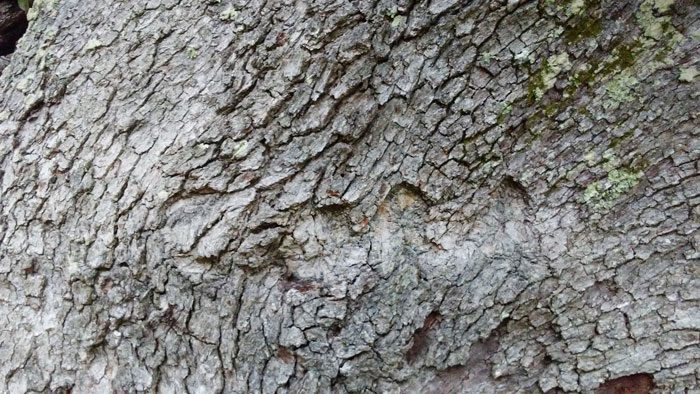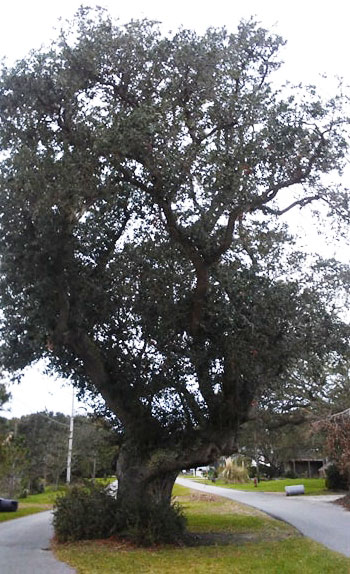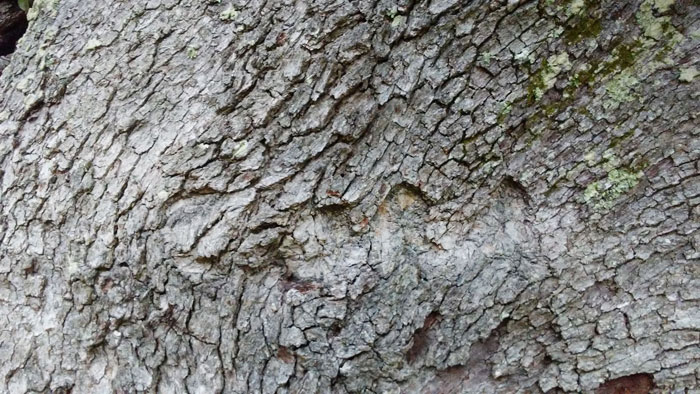
The Outer Banks is a raw, windswept landscape dotted by ancient Southern Live Oaks gnarled by centuries of fierce winds and tropical storms that nurtures creative whimsy and mystical legends. It is no wonder the area is home to ghost sightings, spirits, legends, and lore. Some of these mysterious legends have been seeded and growing from the very beginning of English colonization, and even before. Much of this rich history has been preserved through museums such as The Graveyard of the Atlantic Museum, which showcases shipwrecks and maritime history, but most have been passed down via word of mouth from the “old timers” like Cora, and her tree.
The Legend of the Cora Tree
As the story goes, in the early 1700s, a slight woman and her baby, whom she was never seen without, arrived in Frisco. She managed to build a crude hut for herself and the child, away from the village. She was quiet and did not socialize. People wondered why she needed so much privacy. Rumors began to circulate quickly and often, as you can imagine, about her and the possible bastard child. Being only a short time after the Salem Witch Trials, it didn’t take long for rumors of sorcery and witchcraft to become the general consensus of the villagers.
After all, she had touched a cow, and just days later, it dried up and quit producing milk. Then there was that boy that teased her baby, sticking out his tongue and contorting his face. He suddenly became very ill shortly after and almost died. Not to mention, Cora always had an abundance of fish, and the fishermen were suddenly not catching fish. She had to be a witch.
All this gossiping and finger-pointing would have probably remained just that, being we are in the South and Southern hospitality and all that, but a tattered, busted ship named the Susan G. arrived. Hatteras is no stranger to tattered, busted ships arriving. We are the Graveyard of the Atlantic, and we got that name honestly. However, the Susan G was boarded by Captain Eli Blood and his crew of ruffians, sea worn sailors, and ex-slaves from Barbados.
Captain Eli Blood was a long time native of Salem, Massachusetts. He pronounced himself an exemplary student of all the finest New England traditions, self-proclaimed himself a witch hunter, and decreed himself a defender of the people. You know the type. He immediately set himself up in the middle of town and began hob-knobbing and gossiping with all the other hob-knobbers and gossipers. His crew, however, preferred to set up camp amidst the solitude of the desolate beach, while they awaited the owner to approve the repair of the ship and send money.
After hearing all of the stories of child and animal illnesses, storms, and wrecks that were ALL, apparently, Cora’s fault, it didn’t take long for the good Captain to also become suspicious that Cora was a witch. Then, as if on cue, the body of a local man washed up on the shore. Supposedly, he had a twisted look of terror on his face as if pleading for his life, his hands clasps together as if in prayer, and the bloody numbers 666 carved into his forehead. The most damning evidence of all was the presence of small footprints surrounding the body and leading off into the woods towards Cora’s hut. This strengthened Captain Blood’s resolve that Cora was indeed a witch, and it was his duty to save these good people of Frisco from the misfortune this witch intended.
Cora was a witch and he knew just how to test her, being from Salem and a veteran of the Salem Witch Trials. He gathered up the angry mob, and they marched through the woods to Cora’s hut. They smashed through the crude hut door, grabbed Cora, and snatched up her baby. They took them both to the middle of town near an old oak tree to perform his first test. He took out his knife, and he tried to cut her hair. Just as he had suspected, his knife couldn’t cut her hair because “her hair was stronger than wire rope.” Next, he bound her hands and feet, and he threw her into the sound water. She did not sink, but “floated on top of the water.” There was only one test left. The Captain took out his ceremonial witch hunting bowl, filled it with water and pricked his finger letting a drop of blood fall into the bowl. He instructed three other men to do the same, and they obliged. He then “stirred the water and blood vigorously, mixing it into a froth.” He gazed into the bowl, satisfied with the outcome, and he instructed the other men to do the same, and confirm what he saw – the face of Cora and Satan. Cora’s fate was sealed, as all the men agreed they had seen the same as the good Captain.

With the entire mob of villagers stunned in awe, Captain Blood tied Cora and the baby to the old oak tree in the middle of town. The captain and his men hurriedly gathered kindling and branches at the base of the tree and Cora’s feet. She was to suffer the usual fate of witches for the day; to be burned alive.
Captain Blood was lighting a torch and setting his course straight towards the dry kindling when some of the local villagers, lead by local Captain Thomas Smith, began to protest that Cora should be taken to the mainland and tried in a proper court of law. Remember that southern hospitality we spoke of earlier? Well it doesn’t just allow for innocent people to be burned alive. No doubt some of those that testified against Cora for their own poor fishing when she skunked them with her superior fishing skills were probably starting to feel a little guilty. Captain Smith grabbed Captain Blood’s arm just as it was about to touch fire to pyre. Suddenly, the sunny sky filled with storm clouds, thunder rumbling low. Captain Blood had had enough as he shook his arm free of Captain Smith’s grip to proceed with his plan of saving the villagers of this evil vixen. Court of law be darned; justice will be served.
Just as he shook free of Captain Smith’s grip, the sky opened with a clap of loud thunder and a bolt of lightening directly hit the tree. Everyone was thrown to the ground, loud ringing in their ears, and thick dark smoke filled the air. When the smoke cleared, senses returned, and as the villagers composed themselves, they noticed Cora and the baby were gone. The ropes still hung on the branches of the splintered burnt tree, and the kindling was untouched. The trunk of the tree was ripped open with a big burnt heart-shaped hole. Emblazoned in the exact spot where Cora had been tied with her baby, only the large, capital letters C O R A remained.
This would be just a nice story to shrug off, if the tree wasn’t still standing proud in all her majestic glory in the heart of Indian Town, Frisco. In the middle of Snug Harbor Drive in the Brigand Bay Community, the road splits around an old Southern Live Oak tree as a testament to this legend with the large capital letters CORA carved into the trunk. But could a carving last hundreds of years?
Southern Live Oak trees are evergreen oak trees native to the Southeastern United States. They are fast growing trees until their growth rate dramatically slows at around 70 years old when their trunks reach their maximum trunk diameter. The oldest live oaks in the country have been estimated to be around several hundred to a thousand years old. Southern Live Oaks dot the southeastern United States like The Angel Tree, in Charleston, South Carolina. Although no valid core sample has been recovered from the Cora Tree due to the massive lightning strike through the tree trunk, the Cora tree was estimated to be about 500 years old by LC Research in 2009, using the circumference of the tree. The carving “CORA” is still highly visible on the tree. Carvings on trees do, in fact, last, so long as the carving is done on the trunk and not the branches, where most of the growth occurs. As long as the carving is on the trunk and was carved after or when the tree is almost 70 years old, when the trunk reaches maturity, the carving will survive for as long as the tree does. An example of this is the Basque Carvings in Sierra, Nevada.
It is fun to speculate all the variables of this legend, like who was Cora? Was Captain Tom Smith the baby-daddy? Why was it so easy to kill women on speculation? A quick Google search reveals that Cora got the last laugh, as not much information can be found about anyone else in this story, other than in the legendary Cora herself. There is no record of Captain Eli Blood, Captain Thomas Smith, or the ship the Susan G. What you may discover was that Cora was not a popular name in the 1700s in America, let alone the quaint fishing village of Frisco. In fact, the name Cora did not become popular in Hatteras until the 1910s-1920s, 60-70 years after the women’s movement of 1848 in Seneca Falls, New York for women’s suffrage. Perhaps Cora was the anglicized version of the German “Kora,” which was very popular in Germany in the early 1700s. Maybe Cora was just a lonely immigrant widower, husband lost at sea, imprisoned in her solitude by a language barrier, caught at the wrong place at the wrong time in history for women. This was a day and age where people were superstitious, wary of outsiders, and constantly afflicted by imaginary evil. She would have made an easy pawn in a homicidal cover-up plot by Captain Blood and his crew.
Or does the Cora Tree have a secret history that the legend deflects? The capital letters CORA carved into the tree in Frisco bear a striking resemblance to the tree carved on Roanoke Island with the capital letters CRO and the carving on the post at Fort Raleigh carved CROATOAN. All three CORA, CRO, and CROATOAN are all carved about 5 ft. from the base and 4” tall “in fayre capitall letters.” All of the carvings are similar and give credence to a theory that the carvings are part of a messaging/distress system that John White instructed the colonists to use should they have to leave the original settlement site on Roanoke Island, while White traveled to and from England with life-sustaining supplies. There is a theory still floating around that the “CORA” inscription was left by colonists, as the “CROATOAN” inscription was left as a message to inform White that the colonists were leaving the nomadic hunting and fishing tribe on Croatoan.
In 1588, colonists including Virginia Dare, abandoned the outpost at Croatoan, an Indian village of the late 16th century. There are two archeological sites of this village; H1 Cape Creek in Buxton, N.C., and another in Frisco, N.C., still called Indian Town by locals to this day. The most notable evidence of the correlation between the Roanoke Island site and the Hatteras Island site are the coins and counters recovered by locals at the H7 Archeological Frisco Dune site, noted by William G. Haag. Counters are an antique method of mathematical computation. They are made with malleable metal, a hammer, and a die. The counters found at the Frisco Dune site appear to be the exact same as the counters at the Fort Raleigh site on Roanoke Island. Not only do they have the identical designs, markings, and wordings, but they also have the same irregularities; providing solid evidence that they were made by the same die, and most likely part of the same set.
Frisco would have been the perfect outpost directly across the sound from New Bern. With sand bluffs high enough to watch for and accurately identify passing ships traveling along the usual route from the south past the Outer Banks, while they awaited White’s return with supplies.
Regardless of whether or not the legend or the Cora Tree has hindered or helped research of the Lost Colony, the mysticism surrounding the tree has certainly protected it from being cut down. The tree is so well known, Google Maps recognizes it by name, The Cora Tree, and provides clear directions to anyone who wants to go on a small adventure. According to Google Maps, The Cora Tree stands proud at 50175 Snug Harbor Drive in Frisco. This majestic tree stands tall in the middle of a split road, baring all her scars for the world to see, and investigate.
Was a witch and her baby burned here? Did a secret lover mark the grave of a woman wrongly accused of witchcraft? Is the carving an ancient text message of a colony trying to be found? Maybe none of this theories are true. Maybe all of them are. One thing is for certain – when you stand at the bottom of this tree, examining the very visible scar of the lightning strike, running your finger along the carving CORA as it stares back at you, you know SOMETHING important happened here, and it wants to be known.



